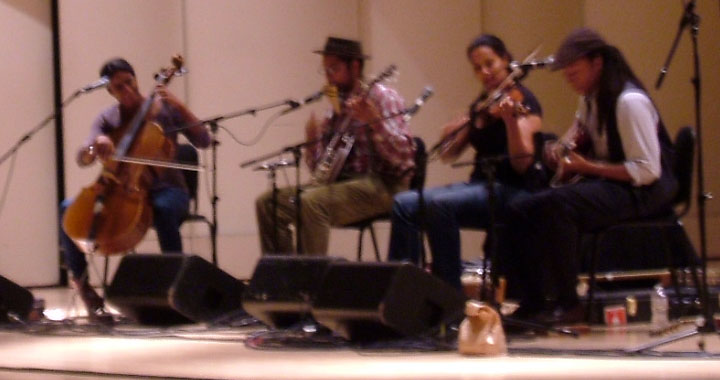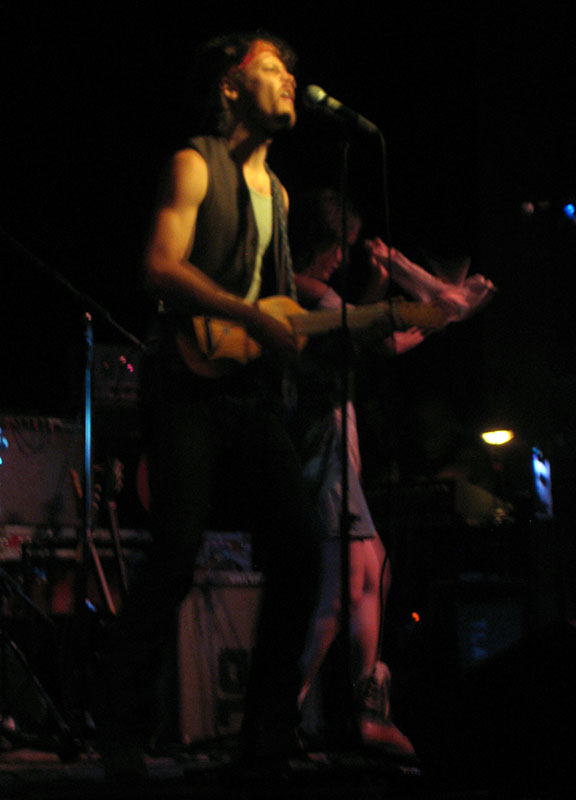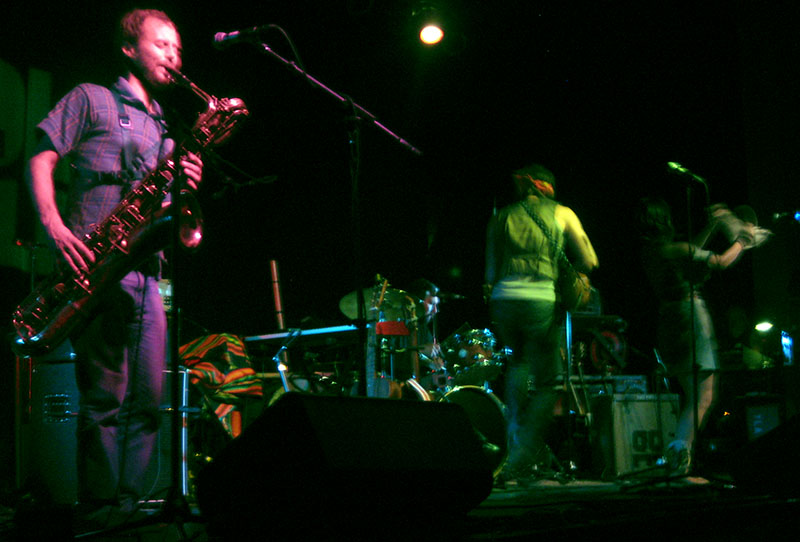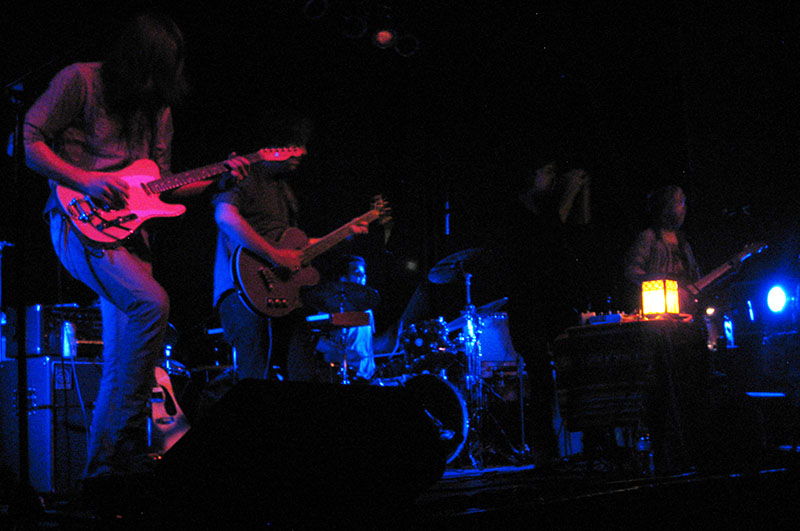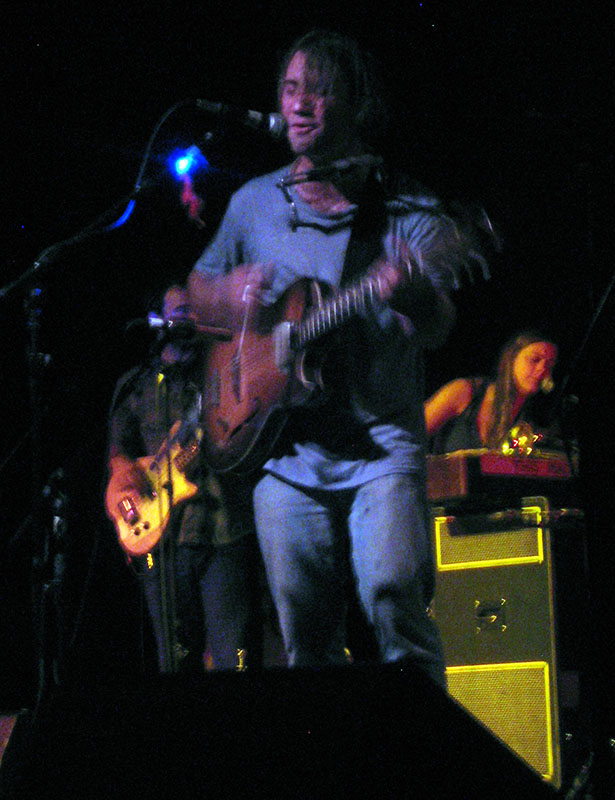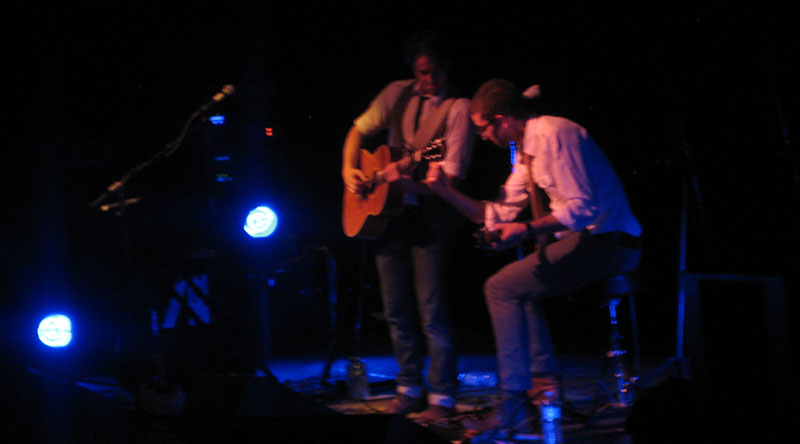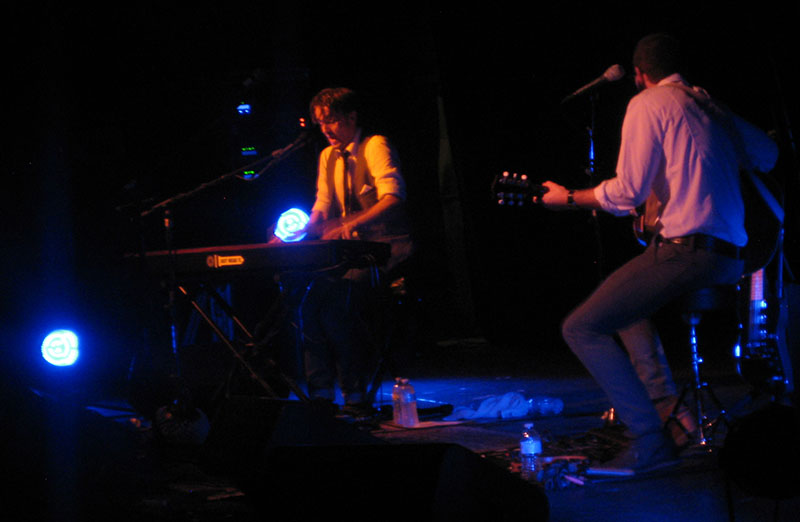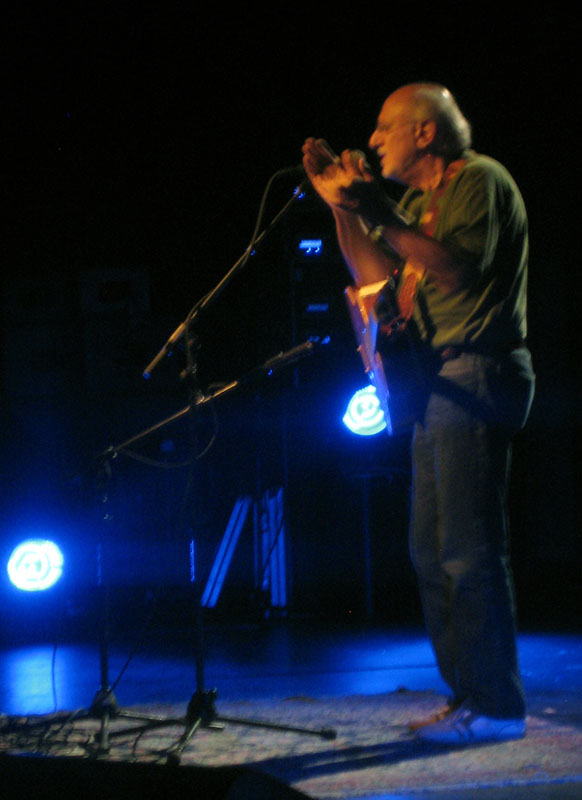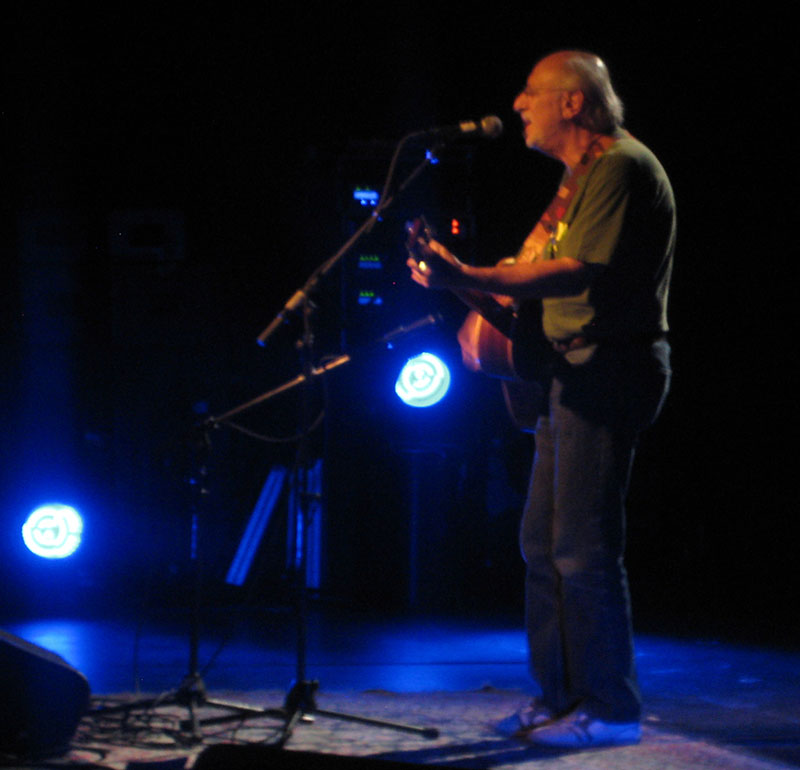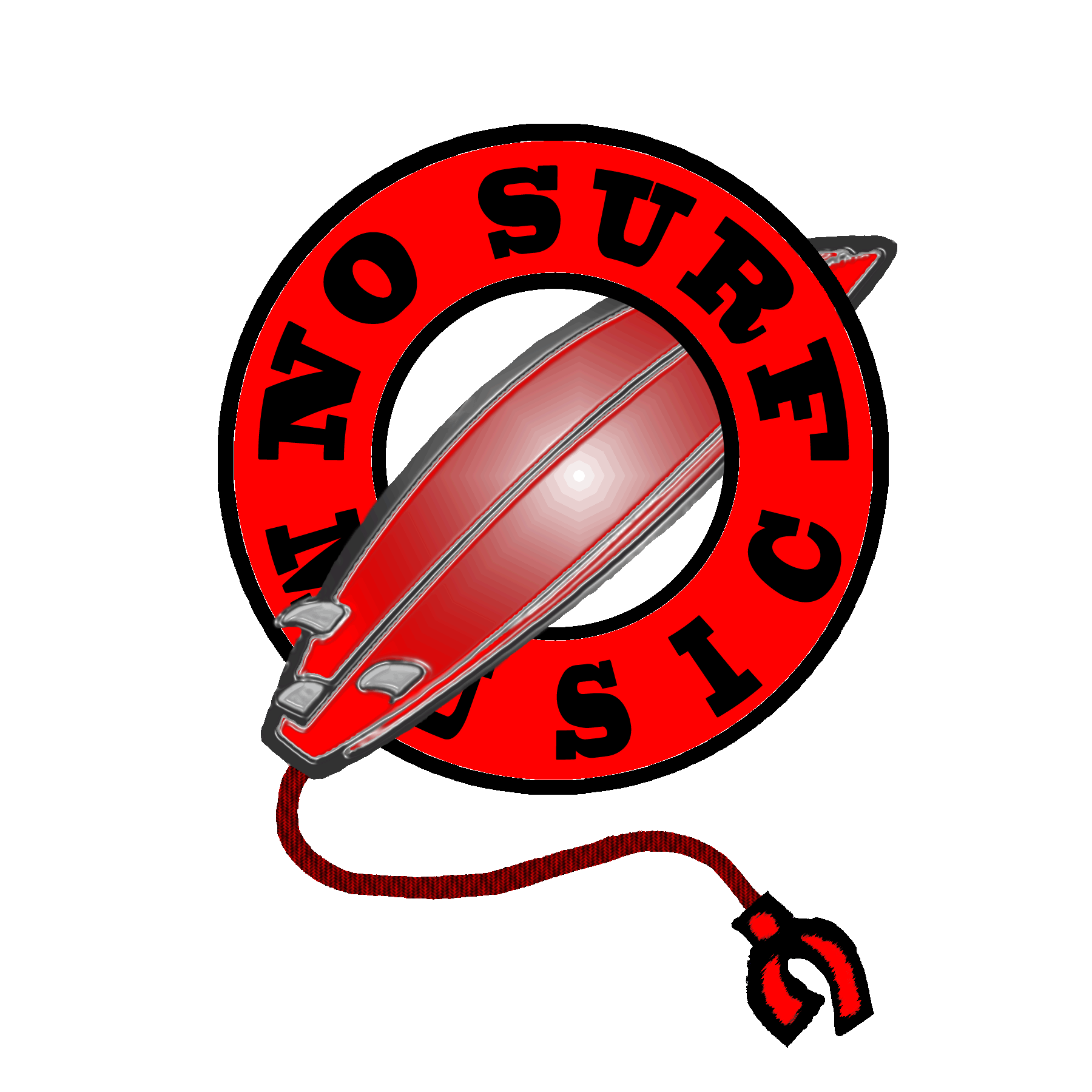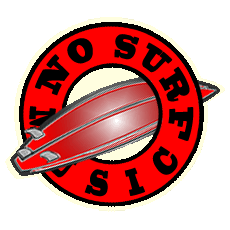
The Lowdown:
October 4th 2011
The 45 Annual Kent State Folk Festival, 9/21-25/2011
by Jason D. 'Diesel' Hamad
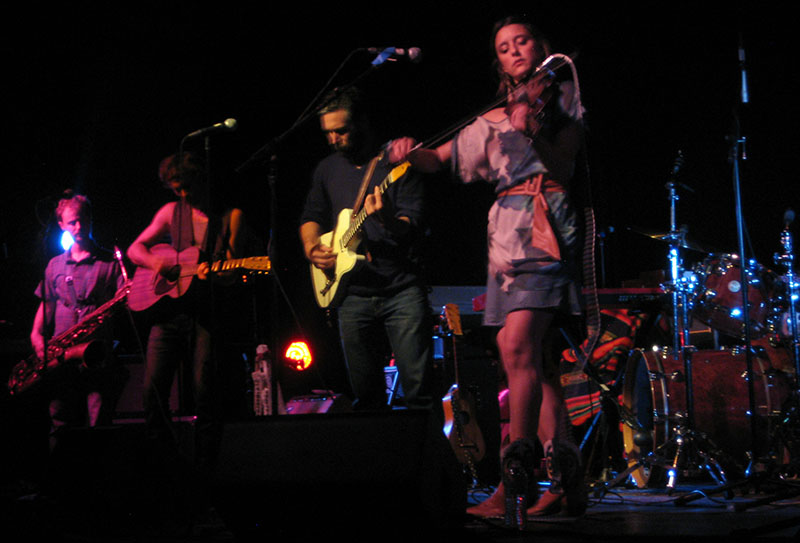
Saturday supporting act David Wax Museum gave the most powerful performance of the entire festival, packed with energy and Mexo-Americana musical magic. (l-r) Alec Spiegelman, David Wax, Greg Glassman , Suz Slezak. Photo by Jason D. 'Diesel' Hamad, No Surf Music.
Every year we at No Surf look forward to a musical event right in our backyard: The Kent State Folk Festival, the 45th annual edition of which took place September 21st-25th. Although it’s certainly not the largest festival of its kind, it is one of the oldest. The event was started by students interested in the folk revival of the mid-60’s—before Kent State became famous as an anti-war hotspot and site of the May 4 massacre. With the participation of WKSU, home of the Folk Alley radio/web broadcasts, it has become a mainstay of the local calendar, attended by alumnae, students and locals of all stripes and featuring an eclectic, genre-bending lineup of up-and-coming bands and folk masters alike. Many of the concerts have moved off-campus and are now set in the beautiful and acoustically perfect Kent Stage, itself an outgrowth of the festival.
This year's participants included acts displaying talents in styles ranging from traditional African-American folk to pop, blues to Mexo-Americana. The opening concert on Wednesday the 21st featured the Carolina Chocolate Drops, while Thursday’s show was headlined by the Dirty Dozen Brass Band with local Northeastern Ohio zydeco jam group Mo’ Mojo opening. Friday, as always, was reserved for the Folk Alley ‘Round Town event, when virtually every Kent bar, restaurant and business opens their doors to feature lesser-known acts of all kinds. Saturday’s headliner was The Low Anthem, backed up by Sleepy Sun and David Wax Museum. The festival was anchored by the legendary Peter Yarrow of Peter, Paul and Mary, who was preceded on the stage by young pop master Seth Glier.
The highlight of the week was undoubtedly the performance by David Wax Museum. With just a short, eight-song supporting set they packed more energy, originality, and musical punch than all the other acts combined. DWM is no stranger to absolutely dominating festival performances. The group first began to gain national attention after winning a competition for a spot to perform at the 2010 Newport Folk festival, at which they gave what many called the breakout performance of the year. They followed this up with another much-lauded appearance in 2011 and have added a long list of festivals to their tour schedule, from Austin to Winnipeg and everywhere in between, augmenting their accolades with every performance. It’s an absolute travesty that they were relegated to such a short time on stage, but given their powerful performance it’s a pretty safe bet that they’ll be offered a more significant presence in the future (and, in fact, they are already planning a return engagement at the Kent Stage this spring).
Wednesday, September 21st: Carolina Chocolate Drops at KSU
The Carolina Chocolate drops opened the festival with their own particular blend of old and new sounds, focussing on traditional African-American music of all types. (l-r) Unknown (don't blame me), Dom Flemmons, Rhiannon Giddens, Hubby Jenkins. Photo by Jason D. 'Diesel' Hamad, No Surf Music.
It’s hard to imagine a more perfect opening act for the festivities than the Carolina Chocolate Drops. The band displays a true reverence for the folk tradition that really comes through in their performance. Focusing on traditional African-American music of many stripes, the recently expanded lineup now features founding members Rhiannon Giddens on vocals and fiddle and Dom Flemmons on vocals, guitar and banjo. Joining in January, New Yorker Hubby Jenkins provides banjo and guitar while vocalist/beatboxer Adam Matta was absent from this performance. The band also added a new cello player just in the last few weeks, but she has yet to be listed in their promotional material and her name was unavailable at press time. All the members add secondary instrumentation of one kind or another to their primary duties, and all kick in at different times with percussion, highlighted by both Jenkins and Flemmons turning out quick-clapping performances on the bones.
In the only major festival show held on the Kent State campus (specifically the auditorium at Cartwright Hall), CCD turned in the most academic performance of the week. They are true music preservationists as well as performers, being sure to name each song before it’s played, explaining its origin and perhaps even telling a story about its composer or how they discovered it. Also, unlike most modern bands, they play virtually the entire show seated in a line, emphasizing the music over stage presence. Still, their playing is anything but sedate and their energy and passion comes through far better on stage than it ever does in their recordings.
The band started out the night with a traditional called “Kehr’s Negro Jig,” which like many such songs had a somewhat Irish feel, played in a minor key. This was followed by the folk classic “Pretty Little Gal with a Blue Dress On,” on which Flemmons played the quills, an instrument more familiar to many as the pan pipes, and which he learned to play from Mike Seeger. This was followed by the Papa Charlie Jackson’s “Your Baby Ain’t Sweet Like Mine,” on which Flemmons played with big, oversized, almost stereotypically “old-timey banjo player” inflections while Giddens took a turn on the kazoo, which she gave to a child in the audience after the song.
The band soon kicked it into high gear with Ethel Waters’ “No Man’s Mamma Now,” featuring powerful blues vocals by Giddens and a terrific guitar solo. Charlie Poole’s “Milwaukee Blues” and a contemporary song by Laurelyn Dossett about the band’s home, “Leaving Eden,” were also highlights of the first set. The latter is a heartfelt tribute to a dying town left destitute by declining industry, and the band played it in a style reminiscent of a Lucinda Williams ballad.
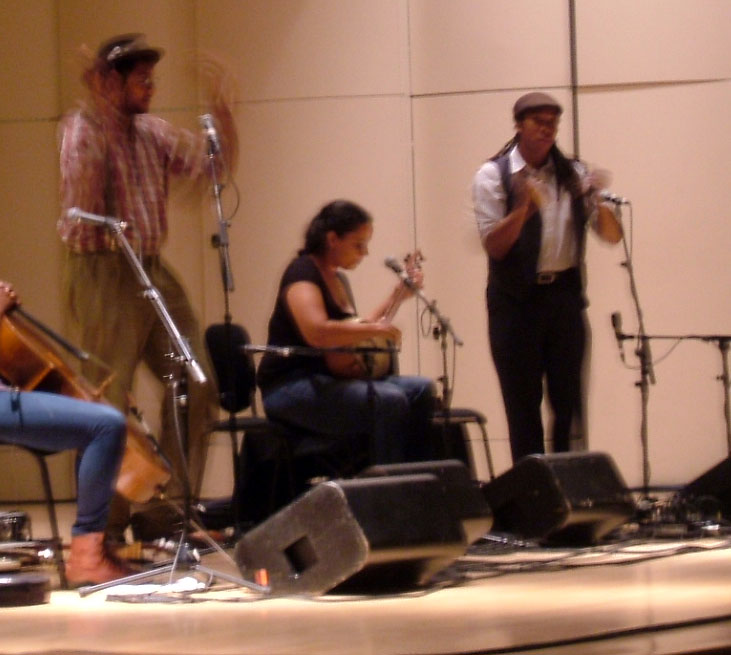
Ok, admittedly the camera we used at this show wasn’t that great, but if nothing else this image demonstrates the crazy quick action of a good bones player. Photo by Jason D. 'Diesel' Hamad, No Surf Music.
After the band returned from a short break, Giddens explained that while Mike Seeger had been a big influence on Dom, she had been influenced more by his sister Peggy. She then broke into an a cappella rendition of a song that the band never performs (as evidenced by the fact that she read the lyrics off of a hand-written notebook in her lap), but which she said she thought particularly appropriate for the show’s setting. The song, which shares a tune with “Come All You Hardy Miners” (a labor ballad collected by Alan Lomax and sung by brother Pete on his 1956 album American Industrial Ballads), decried the rise of corporations and the belittling of the individual in modern society. With its off-the-cuff delivery it was definitely a highlight of the night.
Other notable songs in the second set included the traditional “Polly Put the Kettle On,” “My Money Never Runs Out” by jug band master Gus Cannon featuring Flemmons alone on the banjo, a slide guitar blues rendition of “If I Lose Let Me Lose (Mama Don’t Mind),” the Canadian fiddle tune “Was You Ever in Quebec?” and a collection of mid-19th century minstrel songs featuring Giddens on the gourd banjo and both Flemmons and Jenkins dancing it up on the bones.
Another powerful highlight was a counterintuitive performance of Blu Cantrell’s “Hit ‘Em Up Style” that deftly mixed hip-hop and bluegrass, showcasing Giddens’ undeniably ass-kicking voice. The night closed with an encore performance of one of the band’s most popular tunes, the traditional “Cornbread and Butterbeans.” It was a terrific, spirited performance and a great start to the festival.
Saturday, September 24th: The Low Anthem with Sleepy Sun and David Wax Museum at the Kent Stage
The core of David Wax Museum is the pair of David Wax and Suz Slezak. One of the most unique aspects of the group is their incorporation of traditional Mexican instruments. Here Wax plays a jarana while Suz pounds away on the quijada, a percussion instrument made out of a donkey's jawbone. Photo by Jason D. 'Diesel' Hamad, No Surf Music.
Unfortunately, No Surf was unable to cover Thursday’s performance at the Kent Stage by The Dirty Dozen Brass Band and Mo’ Mojo, nor was it practical for one writer to attempt to encapsulate the plethora of free concerts on Friday night’s Folk Alley ‘Round Town series, so we’ll skip to Saturday’s show at the Kent Stage, headlined by The Low Anthem and also featuring Sleepy Sun and David Wax Museum.
As previously mentioned, the David Wax Museum set was the absolute highlight of the entire festival. Easily one of the most unique bands on the Americana scene today, DWM blends influences from Midwestern American folk, Mexican folk and indie rock music into a potent, eclectic, fire-bellied sound completely unlike anything that has preceded it in any genre. While the band’s energy and joie de vivre clearly come through in their studio work, it is on the stage that they really shine, giving some of the most charged, high-quality performances any listener is likely to see in a lifetime.
While the band has often toured in the past with a three-member lineup including frontman Wax and violinist Suz Slezak accompanied by David’s cousin Jordan, this tour the second Wax has been absent and the band has brought along a pair of multi-instrumentalists who have long played with them near their Boston home as well as on their albums, but hadn’t made the commitment to travel in the past. Alec Spiegelman provided an added kick on the baritone sax and stood in for many of Jordan’s accordion lines on the clarinet, while Greg Glassman added drum rhythms and occasionally stepped out to play guitar. While both David and Suz are always exceptionally energetic, this rounded-out lineup added even more punch to their music than in shows past.
After the show, Wax commented that he felt after a summer touring together the four-piece lineup has really “locked in” and that while it’s unusual for a band to have a bari sax providing the bass line, it was great having Alec on board—especially as he can also break out with dynamic solos—as well as Greg—who not only keeps the beat but can kick in on plenty of other instruments, as well. After hearing this lineup in person for the first time, I would have to wholeheartedly agree.
Just a hint of the action endemic to any DWM show. David dances himself into a sweaty mess while Suz whacks the jawbone with a frantic fervor, all with a howling bari sax and pounding drums to back them up. Photo by Jason D. ‘Diesel’ Hamad, No Surf Music.
The set began with “Yes, Maria, Yes.” One of the band’s most popular and frenetic songs, its jawbone-slapping craziness created a musical frenzy that piqued the crowd’s attention right away. This was followed by the toned-down “Beatrice,” which was dominated by the flowing, rising and falling phrases of Spiegelman’s clarinet and Slezak’s fiddling, combining to give the song a gypsy stomp sound.
The next song demonstrates perfectly why the band is best before a stand-up crowd. As they explained the story behind the Spanish traditional “Chuchumbe”—a song that was once banned by the Catholic Church and which Wax translated from the records of the Inquisition—they asked people to come up to the open area in front of the stage and dance. The song is insanely catchy and forces even an anti-dance partisan such as myself to at least tap along, but they found no luck with the academic Kent State crowd content with their comfy theater seating. Still, the performance was strong and energetic, and the band’s own kinetic energy more than made up for the sedate audience. This was followed up by “The Least That I Can Do,” perhaps Wax’s best lyrical composition and a heartfelt moving-on song that was aptly rendered despite a strange vocal flub on one line.
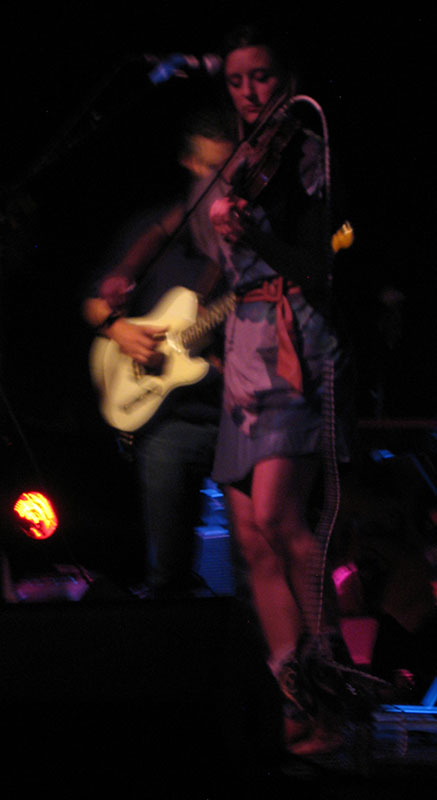
Suz not only provides some mean fiddle action and a powerfully kinetic stage presence, but she adds a little bit of bargain store fashion sense to the lineup. Cute boots, girl. Photo by Jason D. 'Diesel' Hamad, No Surf Music.
“Look What You’ve Done to Me,” was perhaps the most changed rendition given the four-piece touring lineup. In this instance, the arrangement was very dreamy—almost jazzy—with the bari sax playing a big role. It was also notable that Suz took over lead vocal duties. This marks a trend that I’ve noted after seeing the band several times, that Suz seems to be taking a larger and larger role, becoming more of a co-frontwoman in fact rather than just in name. We talked about this after the set, and she agreed with the assessment.
“We started the band together in ’07, and it’s been kind of a journey” to find the right dynamic, she said. “We’ve really worked to be co-frontpeople and it has definitely been a conscious thing for me to take more of a roll. He writes all of the songs, so it’s all from his voice, but we’ve tried to find songs for me to sing that work from a woman’s perspective.” She added that she even plans to try her hand at writing some tracks for the band’s new album, which will be recorded in January.
After Suz’s song in the spotlight came another DWM trademark, a completely unplugged song performed while wandering through the crowd. Usually in the past this has been done on Wax’s spiritual composition “Let Me Rest,” but this time they chose “Carpenter Bird,” the title song of the band’s second album and one of only two songs in the set not from their most recent album, Everything Is Saved. While in smaller settings the act usually just entails jumping off the stage and wading into the parting waters of the crowd, in the deep recesses of the Kent Stage, it turned into more of a parade, eliciting laughter from the crowd as the band members passed by and delighted applause as Wax stood on a front-row seat and interacted with nearby audience members.
Retaking the stage, the band broke into “Persimmon Tree,” the night’s other selection from Carpenter Bird, a rendition that can only be described as “lively as fuck.” After Wax’s court jester antics on the previous piece, the crowd was really into this one, which was helped immensely by the welcome presence of Spiegelman recreating the comically bouncy bari sax part that highlights the studio version. The band then closed off their set with a terrific rendition of the song “Tunnels” which was greatly aided by Glassman on the drums and that can only be described as “lively as hell” (technically that’s two steps down from “lively as fuck,” sandwiching the ever-popular “lively as shit,” but it’s still pretty damn energetic). With its great lumbering beat, powerful vocal harmonies, and chanted climax, it provided a perfect close to the show-stopping set.
Unfortunately, that is essentially where the show did stop. The following band, San Francisco’s Sleepy Sun, was… well, not bad, just not so entertaining. The group’s moniker is a horrible misnomer as they are not sunny at all, but in fact rather dark. That applies both metaphorically and literally. The stage lights were almost entirely off and what little light there was came from a strange square shaded lamp sitting on a table in front of the lead singer. This accounts for the fact that it was almost impossible to get a decent picture of them.
As for the music, it is murky psychedelic rock. The closest comparison might be to the Doors, with no Ray Manzarek but a lot of bass. In fact, it’s very obvious that black-clad lead singer Bret Constantino wants to be Jim Morrison when he grows up. He even held the microphone in a similar manner, two hands gripping it and covering his face. No Surf writer Alan “Pender” Pendergrass compared him to a cross between Morrison and the basement-dwelling, web-caming goth kid played by Chris Kattan in one of those cheap SNL knock-offs of Wayne’s World.
There’s nothing wrong with this kind of music, but it’s the kind of thing that one has to be in the mood for, and after the previous performance, I’d suspect absolutely nobody in the audience was. The band simply didn’t belong on the stage as the night’s other performers and it was a horrible misstep by those that arranged the bill. It was like showing a triple feature with “Bambi” and “The Little Mermaid” sandwiching “Natural Born Killers.” Actually, that might be kinda fun depending on what kind of drugs you’re on.
3/4 of The Low Anthem: (l-r) Mat Davidson, Ben Knox Miller and Jocie Adams. Jeff Prytowsky was busy playing bass in the corner. Photo by Jason D. 'Diesel' Hamad.
Saturday’s headliners, The Low Anthem, then took the stage. Based in Providence, Rhode Island, the band used to pal around with David Wax, etc., and often found themselves at the same open mics. They have some other similarities as well, including the prominence of horns (in this case clarinet and trumpet) and the use of traditional instruments, most notably a saw.
They tend more toward progressive folk, however, and in this case this tendency went too far. While the group’s albums are relatively tight, the show was filled with a lot of self-gratifying musical masturbation. For instance, the traditional spiritual “Don’t Let Nobody Turn You Around” was preceded by a whole lot of pointless weirdness, including several minutes of random crashing with the lights out, followed by an extended stand-up bass solo. Now there are times for twenty-minute drum solos and times for five-minute bass solos, and those are called Rush concerts. Outside of that, such antics add nothing to the music and in fact rather ruined what was an otherwise interesting rendition of the song.
This was the case with the majority of the set. The band showed a lot of promise when they just played the damn music, ranging from Dylanesque ballads to Decemberist-like story songs, from slow and dreamy bowed banjo work to almost bluesy punk rock with lots of shouting. The problem is they hardly ever did just play the damn music, spending more time pretending they are a jam band.
When they settled down and just did what they were there to do, however, they showed a lot of promise. The highlight of the night was the obvious crowd pleaser “To Ohio” which appeared not once, but twice on their album Oh My God, Charlie Darwin. Frontman Ben Knox Miller explained that they don’t often play it live (a mystery since it was one of the band’s singles and easily one of their best songs), but the buckeye crowd was obviously appreciative. Another highlight came in the encore, when they called the crowd on stage to join them for Leonard Cohen’s “Bird on a Wire.” Despite a bit of chaos, it was the most unconceited moment of the set, and therefore one of the best.
Sunday, September 25th: Peter Yarrow with Seth Glier at the Kent Stage
Buzz-worthy pop singer/songwriter Seth Glier plays well-written, complex music that is nevertheless produced with sparse instrumentation. He either plays guitar or piano while accompanied by Ryan Hommel, who adds guitar and a minimal amount of percussion. Photo by Jason D. ‘Diesel’ Hamad, No Surf Music.
Sunday’s concert was opened by 22-year-old singer/songwriter Seth Glier. Now, this site’s motto is “No pop. No crap. No Surf,” but just this once—since the show was part of the folk festival—we’ll make an exception to at least the first part of that. Glier is very, very poppy. But he’s good, writing well-crafted and personal lyrics set to intricate, often catchy tunes. I mean, it’s not my style of music at all, but it’s miles ahead of most of his contemporary competitors, and he has drawn comparisons to such masters of the craft as Billy Joel.
The highlight of the set for me—and the most appropriate for the setting—was the very first song, the title track to his recent album The Next Right Thing. The song is a powerful examination of the nature of man and a call for social responsibility. Performed a cappella except for percussion by both Glier and his accompanist Ryan Hommel, the song is sung in a rousing gospel blues style with a powerful beat. It was a strong turn for a skinny white boy from a New England suburb.
Glier plays the keyboards in an extremely expressive manner that helps keep his shows lively and entertaining. Photo by Jason D. ‘Diesel’ Hamad, No Surf Music.
After that, Glier settled down to a more traditional pop mode, either playing keyboard or guitar while Hommel backed him up on guitar or foot tapped a tambourine. The songs often begin softly and build through several movements with lots of tempo and mood changes, making for more complex compositions than most pop pieces.
The lyrics are finely drawn and often inspired by Glier’s personal experiences. “Walk Katie Home,” for instance, is based on a strange long-distance relationship with a girl in Manhattan for whom he would make a pilgrimage from Massachusetts to meet. “No Place to Land” is about an unnamed musician friend and tourmate who gets wrapped up in the fame game and, as Glier put it during the show, “forgets what it’s all about, the nobility of music.” “First” is another song that comes from his relentless touring, recounting the experiences of returning home, going to a coffee shop, and seeing people he’s known for years in a new light. It also has a reflective political side, with lines about bombs falling in Baghdad and the continued turmoil on Wall Street.
Other tunes, like the lost-love song “Lauralee,” are fictional-character-driven. Glier performed this tune with a particularly animated flair on the piano and a bit of audience participation with clapping and a sing-along part that seemed to make everyone happy.
He is just as adept at covers, such as a terrific rendition of “Where the Streets Have No Name” or the apparently impromptu encore, which featured a virtually a cappella version of Let It Be with just an occasional light flourish from an acoustic guitar and an audience sing-along of the chorus at the end.
The culmination of the festival was somewhat delayed by the late arrival of Peter Yarrow, the main arranger and musical historian for 60’s folk revival supergroup Peter, Paul and Mary. Apparently it is virtually impossible to travel from Burlington, Vermont, where he had played the night before, to Kent, Ohio, and the folk legend’s journey included several horse changes and the portage of his canoe past Niagara Falls. The crowd—which for this show was decidedly more… geriatric... than at the others—grew restless as more and more time dragged by. When he finally did arrive, somewhat later than the audience’s 9:30 bedtime, he walked in through the front door, straight through the crowd, dumped his jacket in the green room, walked right back on stage, waved, and started strumming and singing “Music Speaks Louder Than Words.”
Peter Yarrow may not jump across the stage and he may occasionally ramble on a bit, but it’s endearing and musically he hasn’t lost a step after five decades at the forefront of folk music. Photo by Jason D. ‘Diesel’ Hamad, No Surf Music.
By way of apology for his tardiness, he paused after the song and told a story about a similar situation that happened to him when he was at Cornell and (surprise) president of the folk music club. He had arranged for Josh White to play a show, but he was late. Yarrow went on to fill the time, and when White finally did arrive and the young singer left the stage the legendary singer smiled and said, “No, you’re doing alright, kid. Sing another.”
That’s how the night went. Yarrow would play a little, then talk a little, then play a little while he was talking, then talk a little while he was playing. It was kind of like story time with Grandpa Pete. The topics of these intersong segments ranged from personal stories to historical experiences to explanations of his current activism to commentaries on politics and the decline of modern society. When he actually was singing, though, it was pure gold.
For instance, the second song, a sing-along medley including “This Little Light of Mine,” “Ain’t Gonna Study War No More” and “This Land Is Your Land” was like a mini-tour through the history of folk music. This was followed by an impassioned description of his current work with Operation Respect, which aims to teach children tolerance and stop bullying, and then a rendition of the project’s theme, “Don’t Laugh at Me.” This somehow transitioned into one of his most recent works, the cancer awareness ballad/musical joke of “The Colonoscopy Song.”
After this, his mood turned more serious as he told a long story about his longtime musical partner Mary Travers, who died a little over two years ago. He talked about the last time he saw her, when she was in the hospice, and how as he talked she started to look more and more uncomfortable. Eventually he became concerned and as he left to get the nurse she piped up, “Peter, I wasn’t uncomfortable. I just wanted you to get to the point.” It says tons about both of them. Somewhere in there he played a terrifically impassioned version of “Leaving on a Jet Plane,” a song she’d made famous on the way to jumpstarting John Denver’s career.
Following up on this rather personal episode, Yarrow again moved toward politics, uttering his most memorable line of the night, “This is not remembering when. This is what we need to move forward.” He then played what he called “the greatest song I ever wrote,” a spirited and powerful rendition of “The Great Mandella” from the 1967 Album 1700. This was followed about Anne Feeney’s “Have You Been to Jail for Justice?” (The answer is yes, by the way.)
As the hour grew later, the set drew to a close, and arthritis pain was the only thing keeping half the audience awake, there were still a few children in the crowd, and Yarrow called them onstage to perform the song that even the most politically charged ex-hippie in the crowd couldn’t leave without hearing, the timeless “Puff the Magic Dragon.” After another long explanation about how the song is not about what Ben Stiller and millions of others think it’s about (“There was no grass around in 1959. We had panty raids and beer! But what it’s really about… There comes a time in your life when you have to put childish things aside and do what you can to make the world better.”), he had the “chronological children” sing along.
Yarrow, even after all these years, has an impressive way of maintaining his optimism and communicating the heartfelt emotion behind his songs that make his performance particularly special. Photo by Jason D. ‘Diesel’ Hamad.
Finally, he closed the show with a rendition of “Blowing in the Wind”—complete with a creaking-voiced Dylan impression—which was then followed up with “If I Had a Hammer.” For the encore, with the entire audience on their feet, he played what he called “the most sacred of all these songs,” the civil rights ballad “We Shall Overcome,” with everyone signing along. It provided a powerful and perfectly appropriate culmination for the festival.
All things considered, the 45th annual event can be considered another successful edition of the Kent State Folk Festival. The sets by David Wax Museum, Carolina Chocolate Drops, Seth Glier and Peter Yarrow were all particularly notable, but with each and every act the festival organizers met their charge of exposing the audiences to varied and important music, whether it be from up-and-comers or well-tested legends, and whether they tended more toward folk, rock or blues.
The only complaint would have to be the baffling pairings for the performances. Frankly, if the organizers hope to continue to expand the festival’s range beyond the realm of traditional folk, they are going to have to do a much better job of organizing the individual shows into a workable lineup. No club in the world would stay in business very long if it consistently booked such a mismatch as Saturday night’s grouping. With a festival like this, which instead of selling all-access passes to multiple stages simply bills individual shows, the key is to make each experience coherent and find a way to provide a package that will please that particular crowd’s taste. In this, the festival organizers fell short this year, but there’s no doubt that here at No Surf, we’re already excited for the 46th edition.
| Peter Yarrow (w/ Peter, Paul and Mary) | Carolina Chocolate Drops | The Low Anthem | Sleepy Sun | Seth Glier | David Wax Museum |
|---|---|---|---|---|---|




